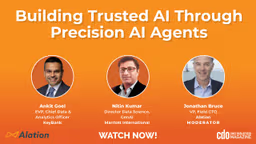AI News Bureau
Don’t Hire AI Talent Without Establishing the Right Ecosystem — Kaiser Permanente Sr. Director, Data Science and Engineering
Written by: CDO Magazine Bureau
Updated 12:00 PM UTC, Tue June 24, 2025
Faizan Javed, Senior Director, Data Science and Engineering at Kaiser Permanente, speaks with Dominic Sartorio, VP of Product Marketing at Denodo, in a video interview about data and AI transformation in organizations, the three generational organizations based on data and AI maturity, value delivery through business alignment, and navigating infrastructure, talent, and strategy in AI maturity.
Data and AI transformation in organizations
Organizational success begins with understanding the organization’s current position in terms of data and AI maturity, says Javed. “We first need to understand where the organization stands in terms of the data and AI maturity,” he asserts.
According to Javed, not all companies are on equal footing when it comes to this journey. A big tech company and a mid-market firm can exist at completely different points along the maturity spectrum. Recognizing that difference is fundamental to forming a realistic and effective strategy.
The 3 organizational generations of data and AI maturity
Javed outlines a model comprising three key stages of maturity that organizations typically fall into. The first-generation organization is building the foundation. “You would probably have to spend time building the data governance layer,” adds Javed. This stage also includes building key layers of storage, privacy, and responsible AI practices.
He cautions against setting unrealistic goals here. “You can’t just say, ‘My organization is at this stage, and I want to build an AI application in the next six months,’ that’s not going to happen.”
The second-generation organization is focused on infrastructure readiness, as the foundational elements are in place. Javed stresses assessing whether the cloud ecosystem is in place and the right tools are available.
“Because if you don’t have the tools, you can’t build anything,” he notes. Illustrating the same with an analogy, he says, “It’s much easier to mow a lawn with a lawnmower versus a pair of scissors.”
The third-generation organization is the one carrying out advanced AI development. Organizations in this tier have robust infrastructure and governance in place.
“I can just focus on the business problems and target really high in cutting-edge AI applications, like building my own LLM, creating it in-house,” Javed explains.
Understanding where an organization stands within this model allows leaders to define clear short- and long-term strategies. Javed emphasizes the importance of balance by stating, “We can’t say that, okay, I’m going to spend the whole year just working on data governance. So how do we balance a short-term and long-term strategy?”
Delivering value through business alignment
While the surge in global AI awareness is promising, Javed warns against pursuing AI for its own sake. In his view, every AI initiative must tie directly into business outcomes and metrics to demonstrate meaningful value and ensure sustained support from stakeholders and leadership.
Infrastructure, talent, and strategy in AI maturity
Next, Javed delves deeper into what it means for a company to operate at the second-generation level of data and AI development. He emphasizes that while infrastructure and foundational elements may be in place, the journey is far from over — particularly when it comes to talent.
At this stage, organizations are no longer grappling with basic data governance or responsible AI protocols. Instead, they have progressed to building the technological ecosystem that supports AI-driven innovation.
Even with infrastructure taking shape, Javed cautions against overlooking skilled talent. He points out that AI talent — whether it is data scientists, machine learning engineers, or AI operations specialists — is in short supply and high demand and they can charge very high salaries. This raises a fundamental challenge for companies outside of big tech, says Javed, to compete on factors such as compensation.
To address this challenge, Javed advocates for a blended talent strategy: “It has to be a combination of in-house and external talent.”
He affirms that most organizations, especially those outside of big tech, prefer a combination of in-house and external talent. In addition to that, he suggests upskilling internal teams and establishing academia-industry partnerships, as everything cannot be outsourced.
Pitfall of a misaligned talent and ecosystem
While discussing the challenges organizations face on their AI journey, Javed highlights a common but critical pitfall of hiring great talent without first establishing the right ecosystem to support them.
He maintains that without the proper data infrastructure, tools, or processes in place, even highly skilled teams end up stuck performing basic tasks.
Javed describes how this scenario often spirals into a negative cycle: “It turns into this vicious loop where they get frustrated and leave. Then you have to start all over again.”
Concluding, Javed says, “When you’re fully mature, you have the right talent, you have the right infrastructure and tooling, you have the right data, governance, privacy policies, storage, retention, and responsible AI, and then you can be an expert on the AI solutions.”
Once this foundation is in place, Javed believes organizations are well-positioned to start with some small solutions and then start going for the moonshots.
CDO Magazine appreciates Faizan Javed for sharing his insights with our global community.





